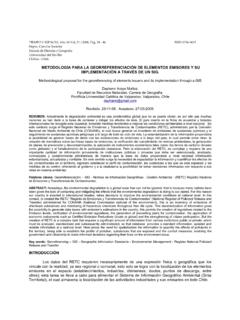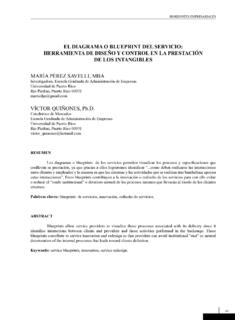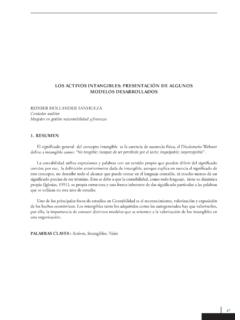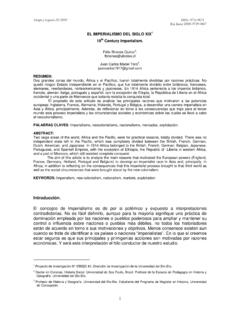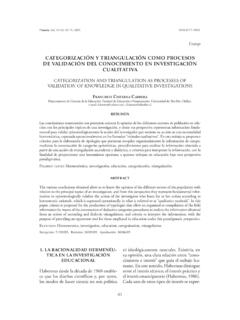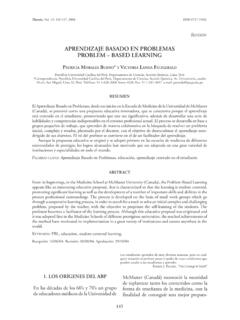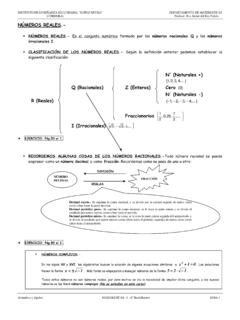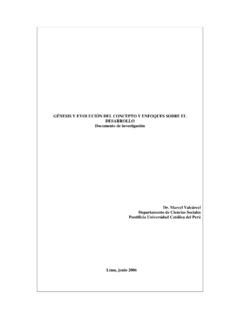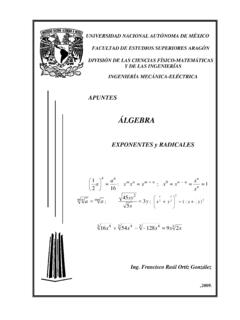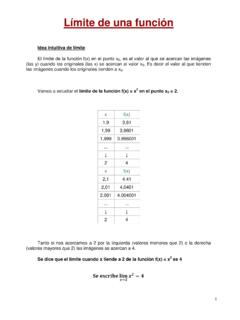Transcription of LAS REVOLUCIONES BURGUESAS DEL SIGLO XIX: 1815-1848
1 17 LAS REVOLUCIONES BURGUESAS DEL SIGLO XIX: 1815-1848 THE BOURGOIS REVOLUTIONS OF THE 19TH CENTURY: 1815-1848F LIX MAXIMIANO BRIONES QUIROZ1*, CRISTI N EDUARDO LEAL PINO2,MAURICIO FERNANDO ROJAS G MEZ3Y JUAN CARLOS MEDEL TORO41, 2, 3, 4 Departamento de Ciencias Sociales, Facultad de Educaci n y Humanidades, Universidad del B o-B o. Chill n, Chile.* Autor para correspondencia: Departamento de Ciencias Sociales, Facultad de Educaci n y Humanidades, Universidad del B o-B o,Chill n, Chile. Avenida La Castilla s/n. Tel fono: 41-203511.
2 Fax: 253519. Correo electr nico: principales olas revolucionarias se produjeron en el mundo occidental entre 1815 y 1848: 1820-1824;1829-1834; y 1848, la m s trascendental de todas. Estas REVOLUCIONES , al igual que la Revoluci n Francesa,fueron BURGUESAS ; es m s, todas las REVOLUCIONES del SIGLO XIX, a pesar de sus diferencias, son hijas de laRevoluci n primera ola revolucionaria posterior al intento de Restauraci n tuvo lugar entre 1820 y 1824. EnEuropa se limit principalmente al Mediterr neo, con Espa a en 1820, N poles en el mismo a o y Grecia en1821 como epicentros.
3 Excepto el griego, todos aquellos alzamientos fueron segunda ola revolucionaria se produjo entre 1829 y 1834, y afect a toda la Europa al oeste de Rusiay al continente norteamericano. En Europa, la ca da de los Borbones en Francia estimul diferentes alza-mientos: B lgica en 1830 se independiz de Holanda; Polonia, entre 1830 y 1831, fue reprimida s lo des-pu s de considerables operaciones militares; varias partes de Italia y Alemania sufrieron convulsiones; elliberalismo triunf en Suiza; y en Espa a y Portugal se abri un periodo de guerras civiles entre liberales yclericales.
4 Por ltimo, Inglaterra se vio afectada por la independencia de Irlanda en tercera y mayor de las olas revolucionarias, la de 1848, fue producto de aquellos a os de crisis. Se fuegestando un malestar social, se buscaba que el pueblo tratara de llegar a las decisiones de Estado. Casi simul-t neamente la revoluci n estall y triunf , de momento, en Francia, en casi toda Italia, en los estados alema-nes, en gran parte del imperio de los Habsburgo y en Suiza (1847). En forma menos aguda, el desasosiegoafect tambi n a Irlanda, Grecia e Inglaterra.
5 Creemos que estas REVOLUCIONES consolidaron el poder de laburgues a en la sociedad europea del SIGLO CLAVES: Restauraci n, revoluci n, burgues principal revolutionary waves were produced in the western world between 1815 and 1848: 1820-1824; 1829-1834; and 1848, the most far-reaching of all. These revolutions, just like the French Revolution,were bourgeois. What s more, all of the revolutions in the the 19th century, despite their differences, areoffsprings of de French the re-establishment intent, the first revolutionary wave took place between 1820 and 1824.
6 InEurope, it was mainly limited to the Mediterranean with, as epicenters, Spain and Naples in 1820 andGreece in 1821. With the exception of the Greek one, all of the uprisings were second revolutionary wave was produced between 1829 and 1834, and affected from all of Europeto western Russia and the North American continent. In Europe , the fall of the Bourbons in France prompteddifferent uprising: Belgium in 1830 became independent from Holland.; Poland, between 1830 and 1831was repressed only after considerable military operations; various parts of Italy and Germany suffered unrest;Liberalism prevailed in Switzerland; and in Spain and Portugal, a period of civil wars between the liberals andthe clericals un folded.
7 Finally, England was seen to be affected by Ireland s independence in , Vol. 14 (2): 17-23, 2005 ISSN 0717-196 XArt culo18 Theoria, Vol. 14 (2): 2005 The third and largest of the revolutionary waves, that of 1848, was the product of those years of unrest was forming; the movement wanted the people to influence the decisions of the state. Almostsimultaneously the revolution broke out and was victorious in France, in almost all of Italy, in all of theGerman stetes, in a large portion of the Habsburg empire, and in Switzerland (1847).
8 Less acutely, theuneasiness affected Ireland, Greece and believe that these revolutions consolidated the power of the bourgeois in 19th century European : Restauration, revolution, n: 05/07/05. Revisi n: 15/11/05. Aprobaci n: 20/12/05 INTRODUCCI NRara vez la incapacidad de los gobiernos paradetener el curso de la historia se ha demos-trado de modo m s terminante que en losde la generaci n posterior a principales olas revolucionarias huboen el mundo occidental entre 1815 y 1848:1820-1824; 1829-1834; y 1848, la m s tras-cendental de todas.
9 Estas REVOLUCIONES , aligual que la Revoluci n Francesa, fueronburguesas. Es m s, todas las REVOLUCIONES delsiglo XIX, a pesar de sus diferencias, son hi-jas de la Revoluci n Francesa. Sin embargo,existen claras diferencias, como las que se- ala Hobsbawm (1998):A diferencia de las REVOLUCIONES de finalesdel SIGLO XVIII, las del periodo posnapo-le nico fueron estudiadas y varios modelos, aunque todos pro-ced an de la experiencia francesa entre 1789y de la ca da de Napole n y su pos-terior exilio en la isla de Santa Elena, losmonarcas y los ministros a cargo de la direc-ci n de las principales potencias europeastrataron de volver a la situaci n anterior a1789.
10 Trataron de negar la historia, pero nose pueden detener los procesos sociales, nipor medio de las leyes, ni por la fuerza. LaRestauraci n fue un proceso ahist rico, ine-vitablemente iba a s del Congreso de Viena las fron-teras de Francia retrocedieron a lo que ha-b an sido en 1790 casi perdi tambi nAlsacia y Lorena y se redistribuyeron des-ordenadamente las fronteras de los antiguosestados europeos para obtener algo que engeneral se asemejaba al trazado del AntiguoR gimen. Rud (2004) se ala:Las potencias victoriosas parec an decidi-das a restablecer el antiguo orden y a repri-mir, si era necesario mediante la violencia,las fuerzas pol ticas liberadas en Europa porla Revoluci los fil sofos de la Restauraci n ha-b a algunos que miraban con a oranza una poca anterior a la Revoluci n Francesa, a laRevoluci n Industrial, a la Ilustraci n, e in-cluso a la Reforma Protestante.


